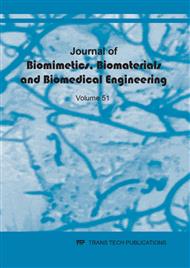[1]
K. Yammine and C. Violato, meta-analysis of the educational effectiveness of three-dimensional visualization technologies in teaching anatomy,, Anatomical sciences education, vol. 8, pp.525-538, (2015).
DOI: 10.1002/ase.1510
Google Scholar
[2]
J. C. Goble, K. Hinckley, R. Pausch, J. W. Snell, and N. F. Kassell, Two-handed spatial interface tools for neurosurgical planning,, Computer, vol. 28, pp.20-26, (1995).
DOI: 10.1109/2.391037
Google Scholar
[3]
S. Friston, T. Ritschel, and A. Steed, Perceptual rasterization for head-mounted display image synthesis,, ACM Transactions on Graphics (TOG), vol. 38, p.97, (2019).
DOI: 10.1145/3306346.3323033
Google Scholar
[4]
S. Whitman, Multiprocessor methods for computer graphics rendering, AK Peters/CRC Press, USA, (1992).
Google Scholar
[5]
J. Ruiterkamp, M. Ernst, L. Van de Poll-Franse, et al., Surgical resection of the primary tumour is associated with improved survival in patients with distant metastatic breast cancer at diagnosis,, European Journal of Surgical Oncology (EJSO), vol. 35, no. 11, pp.1146-1151, (2009).
DOI: 10.1016/j.ejso.2009.03.012
Google Scholar
[6]
J. Preece, Y. Rogers, H. Sharp, D. Benyon, S. Holland, and T. Carey, Human-computer interaction. Addison-Wesley Longman Ltd., UK, (1994).
DOI: 10.1145/191642.1047948
Google Scholar
[7]
H. S. Hasan and S. A. Kareem, Human computer interaction for vision based hand gesture recognition: a survey,, In 2012 International Conference on Advanced Computer Science Applications and Technologies (ACSAT), pp.55-60, (2012).
DOI: 10.1109/acsat.2012.37
Google Scholar
[8]
S. Ruffieux, D. Lalanne, E. Mugellini, and O. A. Khaled, A survey of datasets for human gesture recognition,, In International Conference on Human-Computer Interaction, pp.337-348, (2014).
DOI: 10.1007/978-3-319-07230-2_33
Google Scholar
[9]
P. Garg, N. Aggarwal, and S. Sofat, Vision based hand gesture recognition,, World Academy of Science, Engineering and Technology, vol. 49, pp.972-977, (2009).
Google Scholar
[10]
Z. Chen, X. Feng, T. Liu, C. Wang, and C. Zhang, A Computer-assisted Teaching System with Gesture Recognition Technology and Its Applications,, In Proceedings of the International Conference on Digital Technology in Education, pp.1-6, (2017).
DOI: 10.1145/3134847.3134848
Google Scholar
[11]
C. Graetzel, T. Fong, S. Grange, and C. Baur, A non-contact mouse for surgeon-computer interaction,, Technology and Health Care, vol. 12, pp.245-257, (2004).
DOI: 10.3233/thc-2004-12304
Google Scholar
[12]
X. Xu, M. Sun, X. Sun, W. Zhao, and X. Sun, Research and development of virtual instruments system based on depth camera,, In International Conference of Pioneering Computer Scientists, Engineers and Educators, pp.108-114, (2017).
DOI: 10.1007/978-981-10-6388-6_9
Google Scholar
[13]
X. Zhiqiang, H. Li, and J. He, A novel medical human-computer interaction platform based on Kinect depth image analysis refactoring and neural network,, International Journal of Biomedical Engineering and Technology, vol. 23, pp.315-334, (2017).
DOI: 10.1504/ijbet.2017.10003504
Google Scholar
[14]
Z. Wang, S. Li, Y. Lv, and K. Yang, Remote sensing image enhancement based on orthogonal wavelet transformation analysis and pseudo-color processing,, International Journal of Computational Intelligence Systems, vol. 3, pp.745-753, (2010).
DOI: 10.1080/18756891.2010.9727737
Google Scholar
[15]
M. Hébert, L. Henckens, et al., Changing the color of textiles with realistic visual rendering,, In Measuring, Modeling, and Reproducing Material Appearance 2015, pp. 93980Q, (2015).
DOI: 10.1117/12.2076445
Google Scholar
[16]
J. Artal-Sevil, J. Montañés, A. Acón, and J. Domínguez, Control of a Bionic Hand using real-time gesture recognition techniques through Leap Motion Controller,, In 2018 XIII Technologies Applied to Electronics Teaching Conference (TAEE), pp.1-7, (2018).
DOI: 10.1109/taee.2018.8476122
Google Scholar
[17]
D. Bachmann, F. Weichert, and G. Rinkenauer, Review of three-dimensional human-computer interaction with focus on the leap motion controller,, Sensors, vol. 18, p.2194, (2018).
DOI: 10.3390/s18072194
Google Scholar
[18]
H. Sawant and M. Deore, A comprehensive review of image enhancement techniques,, International Journal of Computer Technology and Electronics Engineering (IJCTEE), vol. 1, pp.39-44, (2010).
Google Scholar
[19]
V. S. Grinberg, G. W. Podnar, and M. Siegel, Geometry of binocular imaging,, In Stereoscopic Displays and Virtual Reality Systems, pp.56-65, (1994).
DOI: 10.1117/12.173906
Google Scholar
[20]
R. Wang, F. Nie, R. Hong, X. Chang, X. Yang, and W. Yu, Fast and orthogonal locality preserving projections for dimensionality reduction,, IEEE Transactions on Image Processing, vol. 26, pp.5019-5030, (2017).
DOI: 10.1109/tip.2017.2726188
Google Scholar


